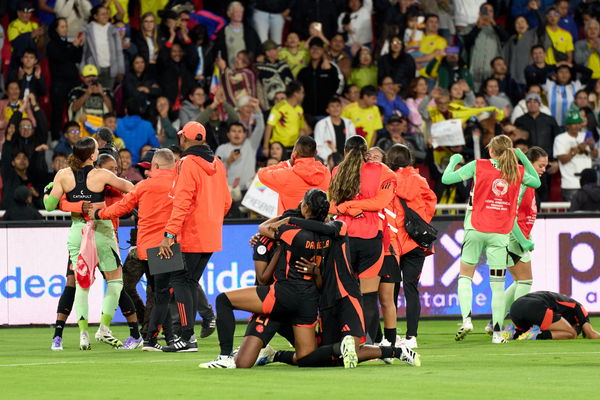
via Imago
Colombia celebrates semifinals win over Argentina of the Copa America Feminina between Argentina and Colombia at Rodrigo Paz Delgado Stadium on July 28, 2025 in Quito, Ecuador Photo by Camilla Stolen, Imago Quito Ecuador Copyright: xCamillaxStolenx L1046874

via Imago
Colombia celebrates semifinals win over Argentina of the Copa America Feminina between Argentina and Colombia at Rodrigo Paz Delgado Stadium on July 28, 2025 in Quito, Ecuador Photo by Camilla Stolen, Imago Quito Ecuador Copyright: xCamillaxStolenx L1046874
We’re almost halfway towards the conclusion of the 2025 Copa América Femenina. The first finalist to potentially make their case for the CONMEBOL tournament is confirmed after Colombia defeated Argentina 4-5 in a close yet exhilarating penalty shootout. This win not only takes them to the last stage of the competition but also sees them earn a spot for the 2028 LA Olympics. While the team effort is all we could say to describe Las Cafeteras’ victory, part of the credit goes to the improved facilities that were once lacking.
Watch What’s Trending Now!
To recall, the 10th edition of this South American tournament, which has been taking place in Ecuador since July 11 and ends on August 2, initially didn’t feature the use of Virtual Assistant Referees, or VAR, due to a lack of investment, resulting in utter chaos with no reviews to correct potential errors. Since then, the word has significantly spread around, and the concerned authorities ultimately took action.
Taking to X, ESPN‘s Jeff Kassouf revealed that VAR is being used in the Copa America semifinals, a facility which, surprisingly, was missing since the beginning of the tournament. And even though the VAR was used, Kassouf admitted it injected an “absolute drama” during the game, as Colombia had a chance to potentially seal the deal in the dying moments of the game after winning the penalty.
ADVERTISEMENT
Article continues below this ad
However, drama ensued as the official, after a VAR check, ruled that the challenge on Colombia’s Manuela Pavi wasn’t significant enough to award Colombia a penalty in added time. Since the Copa América doesn’t allow for extra time—no additional half hour or two fifteen-minute halves—everything came down to penalties. Although Colombia’s Mayra Ramírez missed the fourth kick, Argentina’s Paulina Gramaglia and Eliana Stábile both failed to convert their final attempts, sending Las Chicas Superpoderosas through to the final.
Oh my oh my oh my… Now that there *is* VAR in the Copa America semifinals, we have absolute drama at the end of regulation between Colombia and Argentina (and it's the right decision in a vacuum and would have been a harsh PK if not for the handball). Straight to penalties 👀
— Jeff Kassouf (@JeffKassouf) July 29, 2025
ADVERTISEMENT
Article continues below this ad
The other semifinal features Brazil taking on Uruguay. Then again, it’s not like Argentina and the loser of the second semifinal go empty-handed: all the last four sides of the Copa América have secured their place in the 2027 Pan American Games in Lima. Either way, it was quite an exhilarating match between these two South American sides.
But more importantly, it was the presence of VAR that managed to make the outcome more interesting. While it’s unclear what exactly changed for the CONMEBOL-managed tournament to finally do the necessary, we believe the voices behind it need to be given the recognition they deserve!
Copa América heard the long-heard complaints after all!
At the beginning of the tournament, journalist Jeff Kassouf had already called out the unaddressed issues surrounding the tournament. His critique was echoed by fellow journalist Elizabeth Eads, who didn’t hold back, describing the matches as “terrible” due to inconsistent officiating, further worsened by the absence of video review.
What’s your perspective on:
Is the late introduction of VAR in Copa America a game-changer or just added chaos?
Have an interesting take?
Brazilian legend Marta, witnessing the flaws firsthand, publicly voiced her frustration after Brazil’s second Group B game against Bolivia on Tuesday. She criticized the subpar conditions, especially after players from both teams were forced to warm up in a cramped indoor area at the Gonzalo Pozo Ripalda Stadium. This was because tournament officials imposed the restriction to preserve the pitch, which was hosting back-to-back group stage matches.

via Imago
Colombia celebrates semifinals win over Argentina of the Copa America Feminina between Argentina and Colombia at Rodrigo Paz Delgado Stadium on July 28, 2025 in Quito, Ecuador Photo by Camilla Stolen, Imago Quito Ecuador Copyright: xCamillaxStolenx L1046851
“It’s been a long time since I played in a tournament here in South America, and we were saddened by these circumstances,” said the Orlando Pride forward. Additionally, Brazil’s head coach, Arthur Elias, also pointed to the safety risks players face on such poorly maintained surfaces, while midfielder Ary Borges didn’t hold back either, taking aim at CONMEBOL president Alejandro Dominguez and calling out the glaring disparities between men’s and women’s competitions.
ADVERTISEMENT
Article continues below this ad
“Even amateur matches are better organised than what we have here. Ask Alejandro if he could warm-up in a space measuring five or 10 metres and smelling of paint,” Borges said. Their criticism was soon echoed across borders, with former USWNT players Lindsey Horan and Sam Mewis also speaking out against CONMEBOL’s ongoing neglect of the women’s game.
Then again, the good thing is that the concerned Copa America authorities have made the changes required. Better than never late, right?
ADVERTISEMENT
ADVERTISEMENT
ADVERTISEMENT
ADVERTISEMENT


Is the late introduction of VAR in Copa America a game-changer or just added chaos?